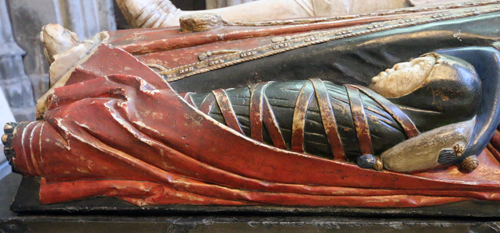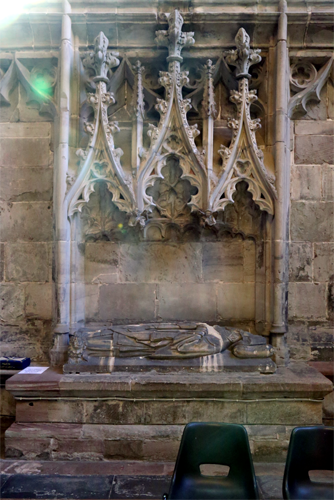| HEREFORD CATHEDRAL | ||
|
The Cathedral Church of the Blessed Virgin Mary
and St Ethelbert Hereford Cathedral was a Cathedral of the Old Foundation |
||
It had been very many years since I visited Hereford Cathedral and then I did not have a camera. While researching for the Herefordshire page I found a number of etchings by T & G Hollis which I thought well worthy of sharing on line. I did not have, nor had I ever been sent, photographs of the monuments in the Cathedral so I posted a list - based on the text of the RCHM Herefordshire entry for the Cathedral until such times as I had some photographs. The cut-off date for the moments in this RCHM work is 1714. The above was written in the summer of 2021 after receiving the Herefordshire RCHM volumes as a birthday present, so we decided to visit Herefordshire in he autumn later that year, planning two days in Hereford City to see the Cathedral and the city itself. However this proved to be a disappointment: parking is relatively expensive and the cathedral was only open one morning of our visit, there being a wedding in the afternoon of one day and a ceremony of the new dean being installed the next. I am presuming this is the term for how these very reverend gentlemen and ladies are welcomed into office. However the staff were friendly and helpful, entry was free and there was no charge or any restriction on taking photographs, except - quite rightly - in the area where the Mappa Mundi is displayed and the chained library. Unfortunately all this was more than offset by the loud and long playing of the organist all morning which drove me - and the voluntary staff to whom I spoke - to distraction. Because of the Covid epidemic several areas were roped off but as these were quite empty this was no problem; the crypt itself was locked. One area was permanently closed off by an opaque glass screen and shelving and I know there is a least one interesting monument behind it. Hereford Cathedral does have a habit of blocking the monuments with articles of furniture, making it awkward and at time impossible to photograph them. One monument is completely surrounded by a pile of chairs and, although you can see the effigy, you cannot read the inscription. The south choir aisle - the one that contains the row of medieval bishops - is roped off 'because it is used as a storage area', although I did ask and was freely permission to visit this area, as would others. The Cathedral really does need to solve this unsatisfactory storage problem. So this is an attempt to combine the original page with my series of photographs; unfortunately I did not have time to note where the monuments were situated so at times there may be errors. Note: I have consulted two reference books on Hereford Cathedral: the Pevsner volume which was published in 1963 and reprinted in 2001; and the RCHM volume which was published in 1931 so we can expect some differences from the situation at out visit in 2021 |
The Bishop's Cloister The Crypt The Lady Chapel The Nave The Nave-North Aisle The Nave-South Aisle The North Transept The North-East Transept The Chancel
The Chancel - North Aisle The Chancel - South Aisle The South Transept The South-East Transept Yard between the two Cloisters
| The Nave |
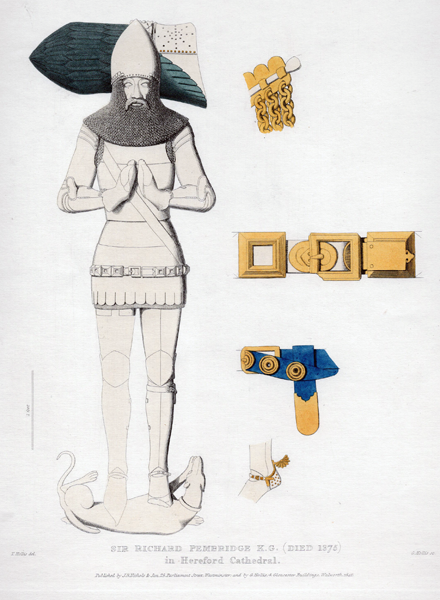 |
  |
| Above and below: [42] Sir Richard Pembridge K.G. (1375) (ascribed) Alabaster altar tomb and effigy. Tomb chest with paneled side alternating with quatrefoils holding his shield of arms, . The right lower limb has been replaced since Hollis's etching. |
 |
| Nave - North Aisle |
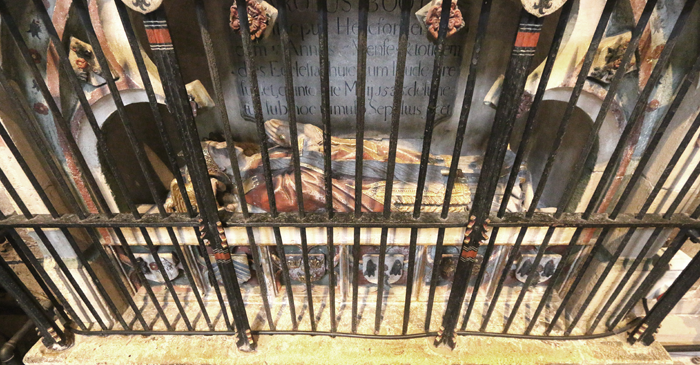 |
 |
| [42] Bishop Charles Booth (1535) Altar tomb with six quatrefoil panels containing carved shields of arms: i. Booth. ii. See of Hereford. iii. Booth. iv. St Ethelbert. v. The Deanery. vi. Booth. Effigy in mass vestments, angels supporting head, feet on lion. In four centre arched recess also with shields of arms: i. Booth impaling the See. ii. Booth impaling the Deanery. (This is the first photograph I took in the Cathedral; through the entrance door and turn left. It is the first example of the annoying habit of the Cathedral of obstructing monuments with furniture; there is a grill there after all! In parish churches I do a little furniture removal but it is more difficult in cathedral where there are more eyes on you! The problem was to get worse - far worse!) |
| The Nave - South Aisle |
  |
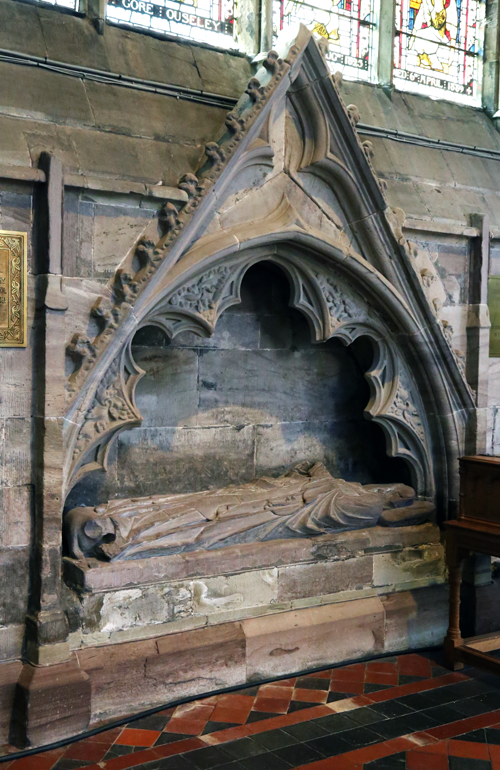 |
||
|
|||
| North Transept |
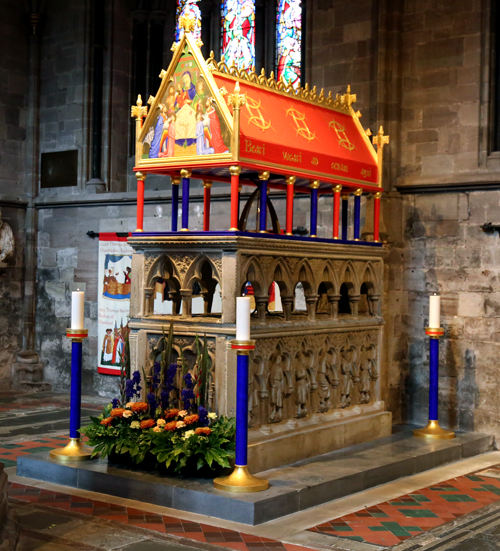 |
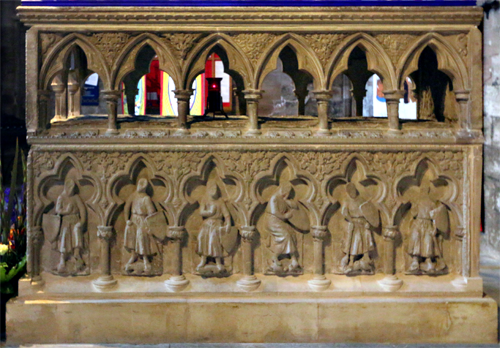 |
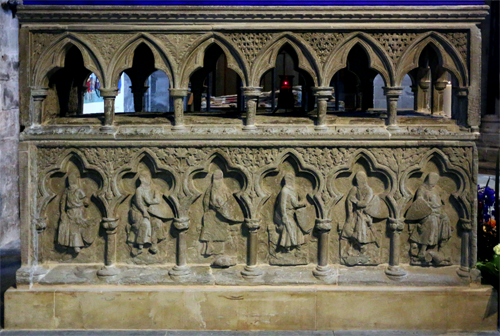 |
| [38] Bishop Thomas Cantiloup (1282) (ascribed) This takes the form of a shrine with an altar-tomb and an open superstructure, with the altar-tomb possible older than the rest. The reassembled altar tomb has six bays on its long side and two on its west, each filled with a figure of a knight. On the slab there is an indent for a brass of a bishop and one for a small figure of St Ethelbert, this latter brass being now in the Cathedral library. The superstructure has an equal number of bays and a plain top slab. The east side, against the wall, is plain and clearly not meant to be seen. | ||
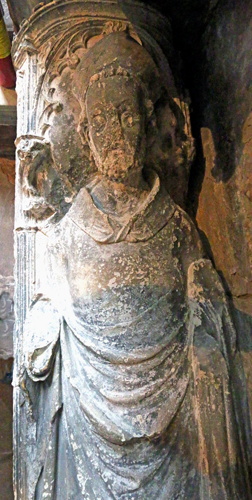 |
  |
 |
| Above
right and centre top: [39] Dean John de Aquablanca
(1320) (ascribed) Low altar-tomb with effigy in
surplice. Head on cushion, feet on lion. Remains of
gablette. Above left and centre bottom; the whole monument is shown below left: [35] Bishop Thomas Charlton (1343-4) Plain altar-tomb with paneled front, half-round effigy in mass vestments, and canopied recess. Gablette over the head. |
||
 |
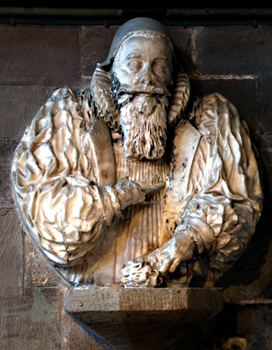 |
 |
|
| Above: see [35] Bishop Thomas Charlton (1343-4) | Above Top: [37] Bishop Theophilus Field (1636) Alabaster bust, wearing rochet, chimere, ruff, skull cap, and beard. Holding book. Some traces of colour. Above bottom: [36] [Bishop Herbert Westfaling (1601-2)] Modern base with effigy, wearing rochet, chimere, skull cap and long beard. Head on large cushion, right hand raised to head. Original base destroyed but backpiece remains in bishops' cloister, N. wall.. |
 Above and right: Bishop Atlay (1894) White and red marble by Forsyth |
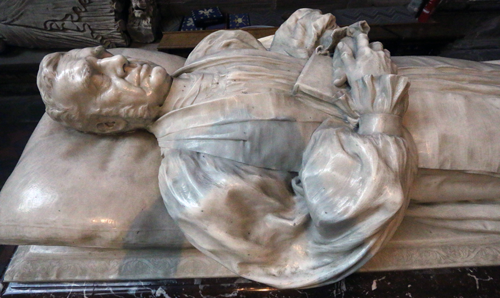 |
 |
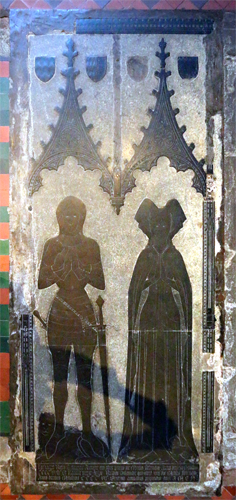 |
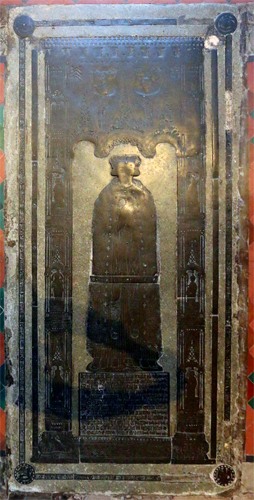 |
| [25] Richard Delamare (1435) and his wife, Isobel (1421) | [26] Edmund Frowsetoure (1529) Dean of Hereford Note the figures of saints in the side panels |
| One further brass [27] of the 16th century is reported by the RCHM | |
| South Transept |
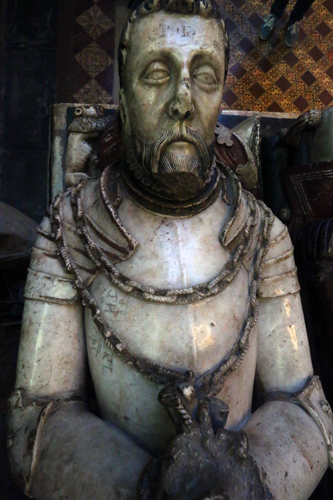 |
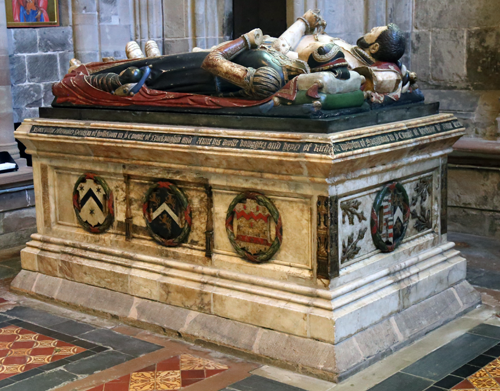 |
 |
||||||
|
||||||||
| The Chancel - North Aisle |
| The first monument is between the North Transept and the North Chancel Aisle |
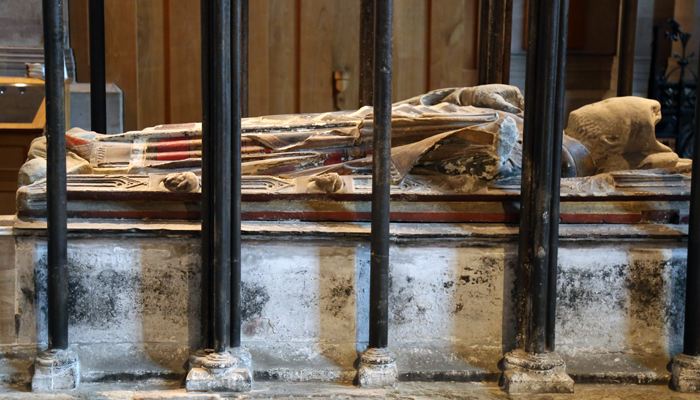 |
[29] Bishop Peter de Aquablanca (1268) Altar-tomb, effigy and canopy. Plain altar-tomb, stone effigy, mass vestments with some remaining colour. The Photograph was taken from that transept and is not entirely satisfactory. Those taken from the aisle failed. Photograph of canopy needs to be included. |
| The following monuments are between the North Chancel Aisle and the Chancel. The photographs were taken from the aisle |
 |
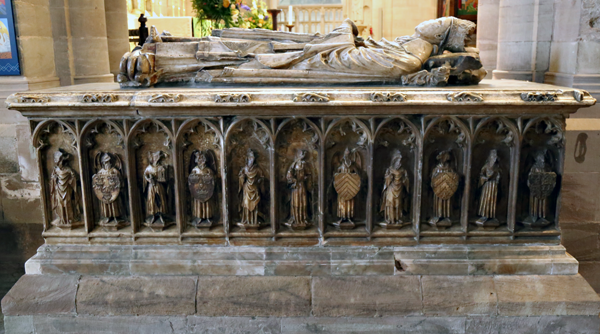 |
| [20] Bishop John Stanbury (1474) Alabaster effigy and brass, in mass vestments, and altar tomb on stone base. Head on cushion supported by angels, feet on lion. The tomb chest is surrounded by a series of weepers: saints and angels holding a shield as well as other items: i. bishop, ii. St Ethelbert with sword and model of church, iii.bishop with object. iv. Virgin and Child. v. bishop. vi. Edward the Confessor with scepter and ring. At ends: i. See of Hereford. ii. St Ethelbert. iii. The Deanery. iv. Stanbury. v. The King. On wall to west brass plate with inscription reset. |
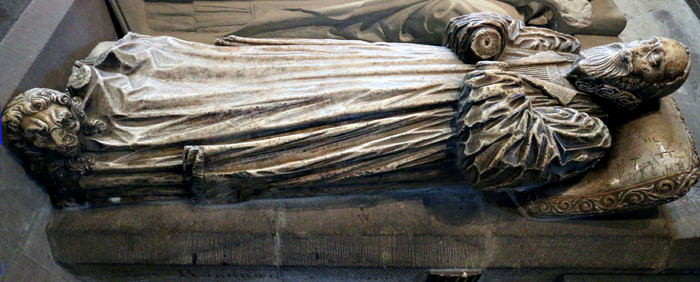 |
 |
| Left: [22] Bishop Robert Bennet (1617)
Alabaster effigy in rochet, chimere, ruff and
skull cap. Head on cushion, feet on lion. Shields of
arms. Canopy destroyed. This effigy is on the aisle side Above : [21] Bishop Giles de Braose (1215) ? Late 13th century stone effigy in mass vestments holding a model of a building. Head on cushion, feet on pedestal. The effigy is next to 22 but on the chancel side |
| The following effigies are under arches in
the north wall of the north chancel aisle. These are a beginning of curious retrospective monuments of early bishops executed early 14th century. Pevsner makes silly, petulant remarks about them which are quite unnecessary. |
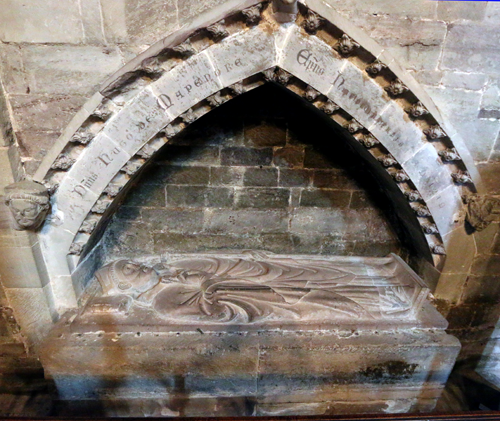 [28] Hugh de Mapenor (Bishop 1216 - 1219) Erected c. 1300 |
|
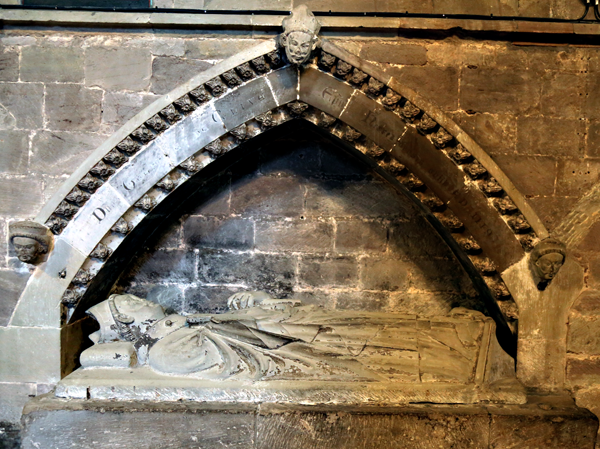 [27] Geoffrey de Clive (Bishop 1115- 1117) Erected 1300. |
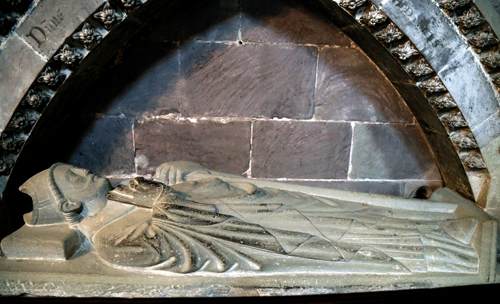 [24] Reynelm (Bishop 1107-1115) Erected c. 1300 |
[25] RCHM: 'In the Stanbery chapel, in recess in S. wall ...effigy...similar to last' [24] and moved with a similar recess in the aisle when the chapel was built'. There remains, '...W part of original recess to the W. of doorway of chapel'
The Stanbery chapel is itself numbered [26]
| The following monuments are between the South Chancel Aisle and the Chancel. The photographs were taken from the aisle |
 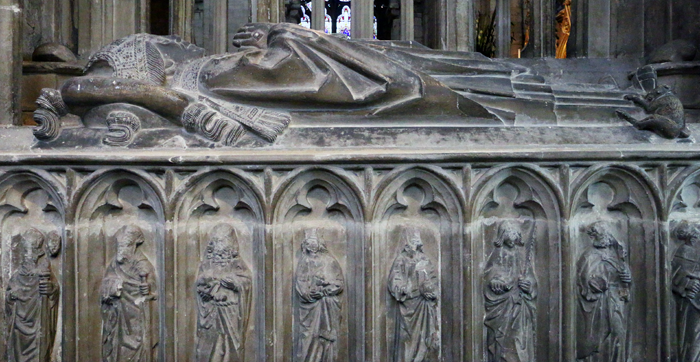 |
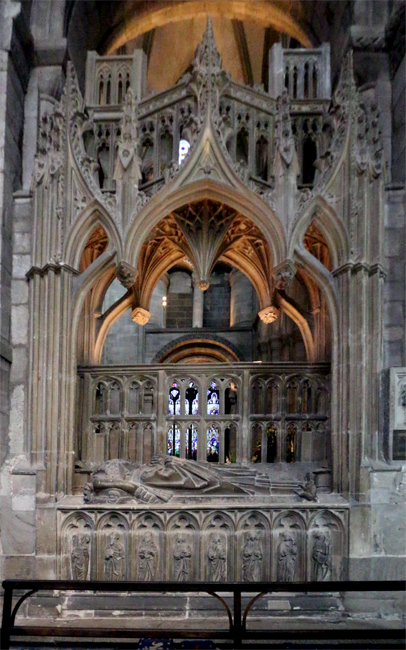 |
Above bottom and right: [23] Bishop Richard Mayhew or Mayo (1516) Effigy in mass vestments on altar tomb with figures of saints. Two animals at feet, head on cushion Triple arched canopy with fan vaulting. The trefoil panels contain saints: i. St Ethelbert with sword and church. ii. St Peter. iii. St John the Evangelist with book and palm. iv. Christ holding orb. v.Virgin and Child. vi. St John the Baptist with lamb and book. vii. St Paul. viii. Bishop (St Thomas Cantilupe) Above top: Bishop Robert of Lorraine (or Losinga) (1095) (ascribed) but erected c. 1300. Similar to [21] and also holding a model of a building. Brass plate indent on wall above. |
 |
 |
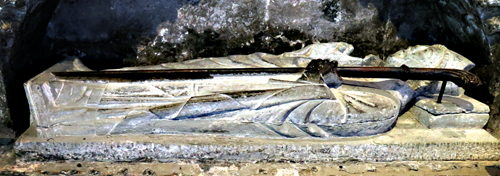 |
 |
Apart from top right these photographs are unsatisfactory - especially right bottom as he does have a head. I do not know what happened but I will replace them in due course. From the east these are: [31] William de Vere (1198), [32] Gilbert Foliot (1187), [33] Robert de Bethune [1148], [34] Robert de Melun (1166-7) All erected c. 1300 |
|
| The North-East Transept |
This is used partly as a storage area for chairs, which obstruct some monuments, and is partly closed off by a wooden screen with opaque glass panels through which we could see a large amount of shelving. I was unable to insert a camera over the screen to at least make an attempt to photograph the monuments beyond. I find it rather dissapponiting that the public are denied access to this area - but see note below. |
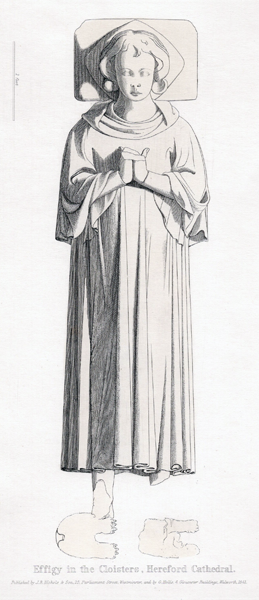 |
Pevsner mentions the following in the Herefordshire volume: [6] Bishop Parfew (1557), referring to the altar tomb as above and the effigy as a ,'shapeless lump" [7] Bishop Swinefield (1337), mentioning 'no effigy left' [8] is almost certainly the effigy in the photograph below left: it is against the south wall, civilian male, as described by the RCHM. Pevsner also describes it as 'recess with ball flowers' the civilian effigy as 'badly defaced' but gives the date as late 13th century. He refers to 'four unamed stone effigies on the floor', all early 14th C. He does not mention the gender. These probably refers to [11], [12], [13], and [[14] above. In the RCHM volume there is a photograph of these four effigies. [14] is without any doubt the effigy drawn by Hollis and shown on the left. He mentions 'a foliated coffin lid, 13th C' and 'parts of several others'. Also 'indents for infilling of composition, priest late 14th C and knight early C15. Also Dean Dawes (1869) by Mathew Noble, 1890. White marble effigy on veined black marble slab. This is shown in the left lower photograph below; it is outside the screen but, rather unfortunately, now surrounded by chairs. The upper photograph in the centre is possibly of a bust to James Thomas (1757); Pevsner lists this as being in the South-East Transept. Neither of the last two monuments are listed in the RCHM volume as they are after the cut off date. There is no mention of [9], [10], nor [15]. The two photographs in the right row below which get no mention in the RCHM, being beyond the cut off date, and are of no interest to Pevsner are: Top right: John Butler (1802) Bishop of Hereford; Bottom right: William Elliot (1903) Prebendary and rural dean of Hereford. Note: We were not able to visit the crypt on our recent visit, it being locked. Recent photographs show four medieval effigies in the crypt; these are not referred to in the relevant RCHM nor the Pevsner volumes so they may well be those mentioned above, which have been moved in the intervening years. |
||||||||||||||||||||||||
| The RCHM reports that there is a
medieval floor slab against the wall in this transept. Also twelve brasses [2-13] , some fragmentary, from the 15th to 17th centuries Also two brass indents [1,2] of the 14th and 15th centuries |
|||||||||||||||||||||||||
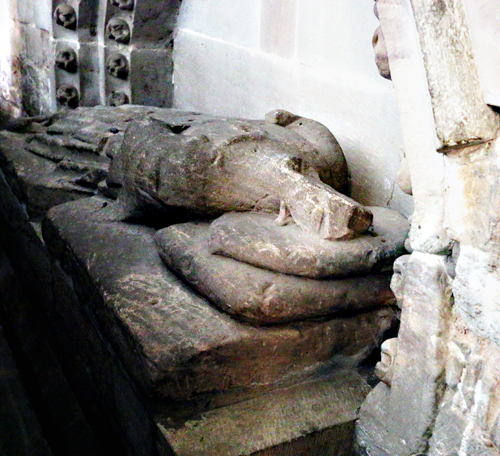 |
 |
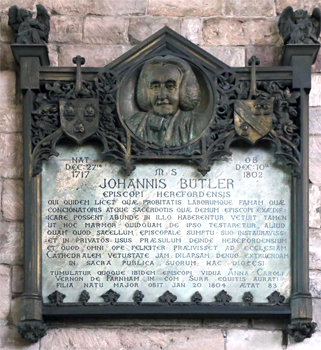 |
 |
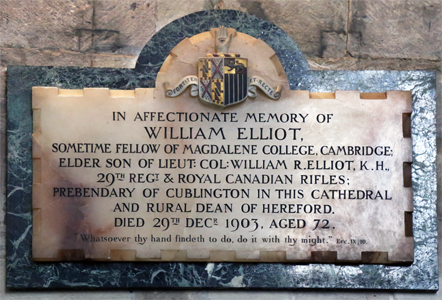 |
|
| The South-East Transept |
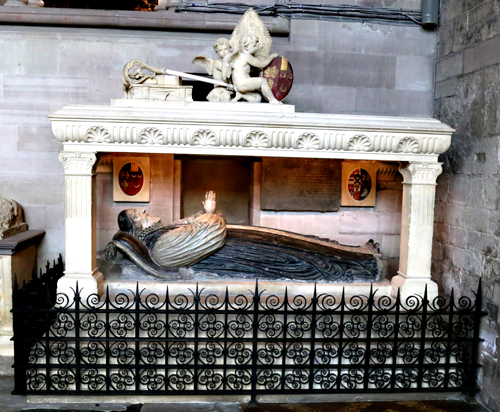 [16] Bishop George Coke (1646) Effigy wearing rochet, chimera, ruff, and skull cap. Head on head on tasseled cushion. Base and canopy are modern. The elaborate wall monument destroyed by Wyatt; the inscribed slab now in Bishop's Cloister. |
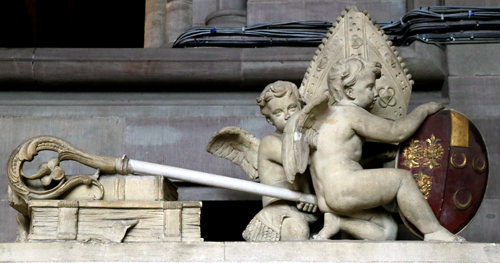 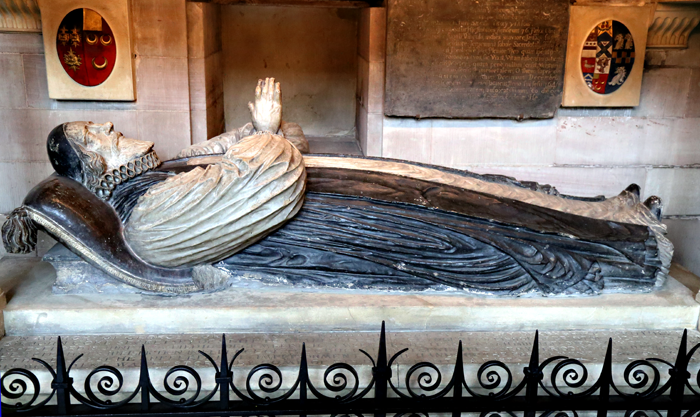 |
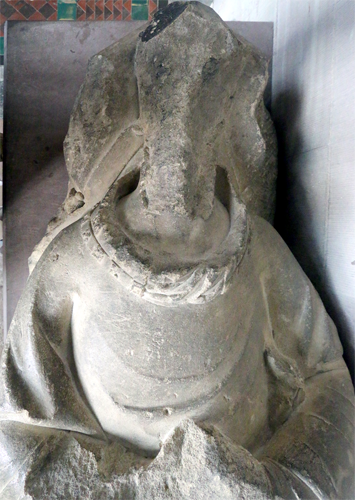 |
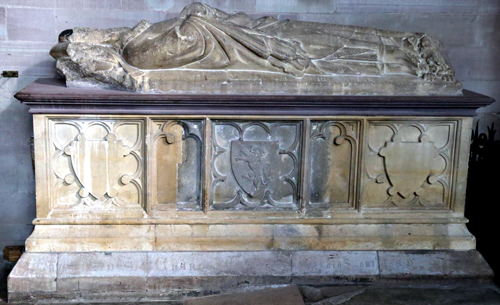 |
 |
|
| [17] [Bishop Lewis Charlton
(1369)] Effigy in mass vestments, much defaced.
Feet on lion. Canopy destroyed. Most of altar tomb is modern. The arms on the central (original) panel are those of the Bishop; those on the west end (not shown) are those of the see. |
 |
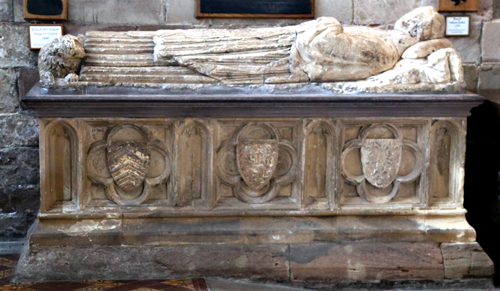 |
 [19] Dean John Harvey (1500) ? Early 15th century altar tomb from Tevenant monument [41] with quatrefoil panels alternating with trefoil headed panels, in larger panels are shields of arms to Deanery, Trevant, See of Hereford.. Alabaster effigy of c. 1500 wearing mass vestments, head on cushion, feet on lion. The arms are Trevant. Much defaced. |
 |
 |
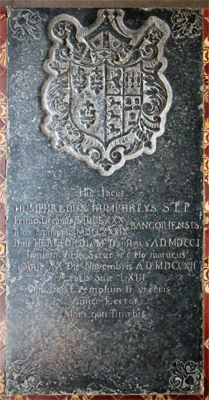 |
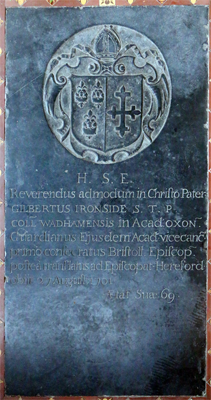 |
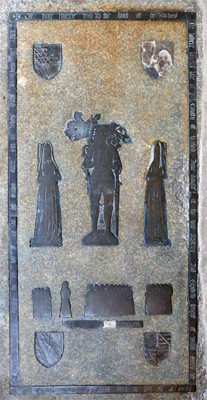 |
| possibly [16] (1434) RCHM does not refer to the canopy however |
Hugi Morgan STP (1809) | Humphrey Humphreys (1712) | Gilbert Ironside STP (1701) Bishop of Hereford Moved here from St Mary Somerset, London |
[23] Sir Richard Delabere (1514) and his two wives: Anne (Awdeley) and Elixabrth (Mores) |
|
| The Lady Chapel |
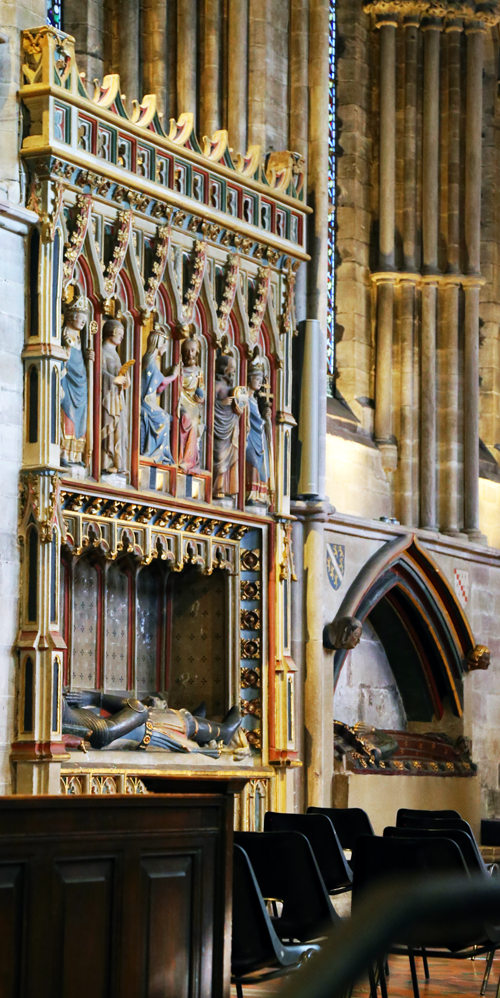 |
 |
 |
| Far left: The monuments of Peter de
Grandison and Joan (Plunkenet)
in the north wall of the Lady Chapel. Left:
Peter de Grandison. Above: Joan (Plunkenet) The shields of arms are: Plunkenet and Bohun. The monuments have been repainted since the RCHM survey |
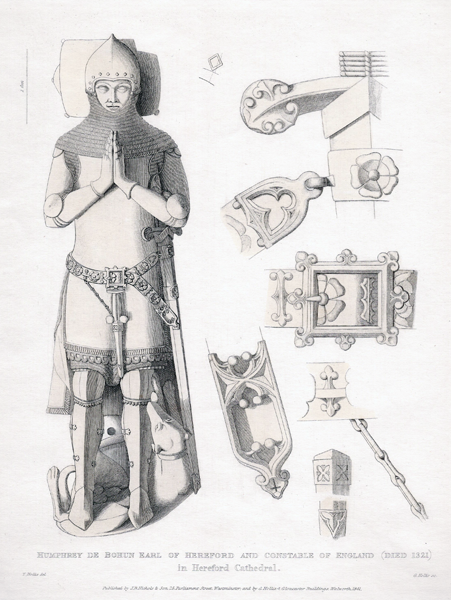 |
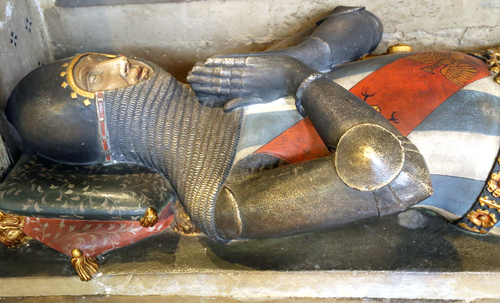 |
 |
|
| [2] Peter de Grandison (?) Mid 14th century effigy, altar tomb with effigy and canopy. He wears mixed mail and plate armour with camail and bascinet; shortened surcoat; carries sword and dagger (the latter worn in front). Head on cushion, feet on hound. Hands in prayer, legs straight. Left: Hollis ascribes this effigy to Humphrey de Bohun, Earl of Hereford and Constable of England (1321) |
 |
 |
| Left and above: [1] [Joan (Plunkenet)] wife of Henry de Bohun (1327)] Effigy on plain altar tomb set in 13th century recess. She wears a wimple and veiled head dress, tight sleeves and loose gown; head on cushion, feet on dog. Traces of black and red colour. |
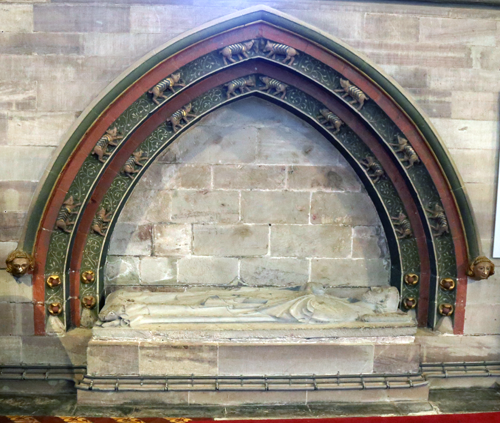 |
  |
[4] Member of Swinefield family (?). Early 14th century. Effigy in cassock and surplice with doctor's cap on head on plain altar tomb in recess. Some of the pigs - swine - on the arch have the arms of the deanery on their backs. The RCHM reports remains of a painted figure on the back of the recess, showing kneeling figure of the doctor of the doctor before the Virgin with attendant figure. NOT RECORDED: [3] Chantry chapel of Bishop Audley. Brass to Richard de la Barr (1386) Canon . |
| The Crypt |
| We were not able to enter the crypt, it being locked at this time. |
| [5] | Andrew Jones and
his wife, Elizabeth (1497) Plain
low alabaster altar tomb with incised figures.
Civilian costume. His feet on a tun. Canopy over
figures. Marginal inscription. Thet reconstructed
the crypt. |
Note |
See above in the North-East Transept section where there is a reference to four medieval effigies now in the crypt |
| The Bishop's Cloister |
The East Alley of the Bishop's Cloister now contains the café and shop; the South Alley does contain a few monuments but now houses the Mapa Muni in its western aspect. The West Alley, with the exception of the south aspect with contains the chained library, is mostly destroyed. I only discovered one monument from the list below, which is taken from the RCHM volume. Their cut off date is 1714 |
| 47 | Joscelyn (1638) and Samuel (1645) Aubrey Plain black marble tablet; rest destroyed | |
| 48 | James Clerke (1640) Wooden panel with painted inscription | |
| 49 | Edward Gwyn (1690) Plain black tablet, surround missing | |
| 50 | Sarah (Broome) (1689) Wife of successively Robert de la Hay and Canon William Johnson. Plain marble tablet | |
| 51 | [Prebendary William Evans](1659) and his wife, Mary. Portions only. Their busts from this monument are now in the triforium of north transept. | |
| 52 | Jane (Fell) wife of William Bowdler (1660) Oval black marble tablet, rest destroyed | |
| 53 | Edward King (1648) Wooden panel with painted inscription and cartouche of arm | |
| 54 | Richard Philpotts (1673) and his daughter, Elizabeth, wife of Humfrey Walter. Wooden tablet with painted inscription and cartouche of arms. See below | |
| 55 | William Barrol ... and his wife, Mary (1698) Wooden tablet with painted inscription. | |
| 56 | Hannah Lowe (1656), wife of William Lowe, and their infant daughter, Hannah (1653) Gray marble tablet with moulded surround and cherubs heads | |
| 57 | Philip Hunt (1698/9) and his daughter, Martha (1694) Plain black marble tablet | |
| 58 | Mary (Seaborne) (1665), wife of William Bowdler. Plain black marble tablet | |
 |
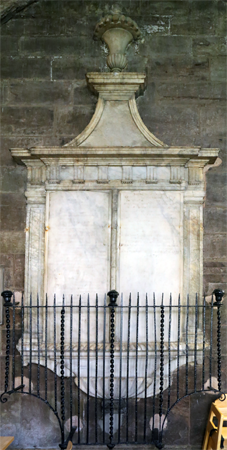 |
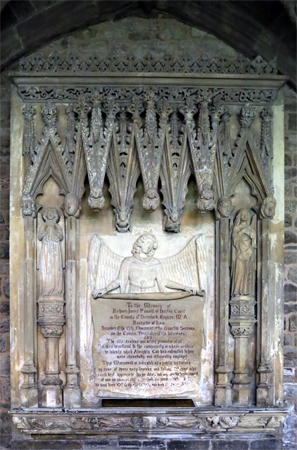 |
 |
|
| No visible inscription | Inscription worn to illegibility | Richard Jones Powell
MA Barrister-at-Law Dates are worn |
Rev John Clutton DD
(1838) Twenty four years canon residentiary |
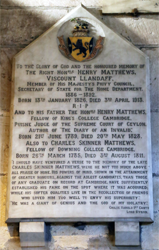 |
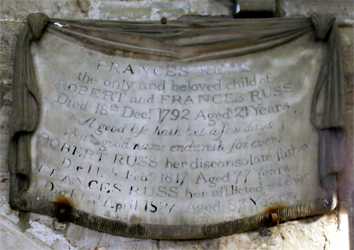 |
 |
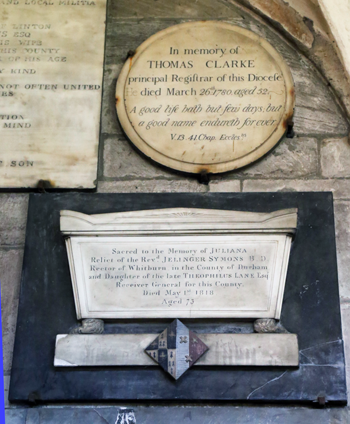 |
 |
 |
| Rt Hon Henry Mathews PC, Viscount Llandaff (1913) . Also his father, Hon Henry Mathews (1828) Puisne-1 Judge of the Supreme Court of Cylon. He wrote 'Diary of an Invalid'. Also Charles Skinner Mathews (1811). There is a long quotation from Byron's Childe Harold below the names. | Frances Russ (1792). Her father, Robert Russ (1817) and mother, Frances Russ (1827) | Eliz: (1745), wife of Timothy Frizer Tanner | Top: Thomas
Clarke (1780) 'Principal Regiſtrar of the Dioceſe' Bottom: Juliana Symons (1818) |
Caroline (1909), wife of the Archdeacon of Hereford, Frederick 13th Baron Say and Sele; and daughter of the Dean. | Top: Hugh
Powell (1749) and his mother,
Elizabeth (Gwynn) (1729) A note adds it
was restored in1899 Bottom: Richard Johnson (1836) Other details obscured |
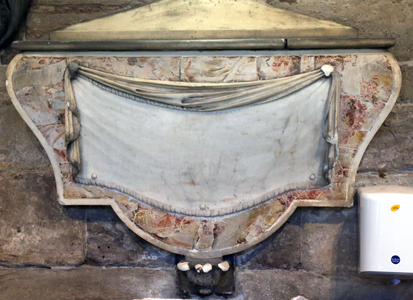 |
 |
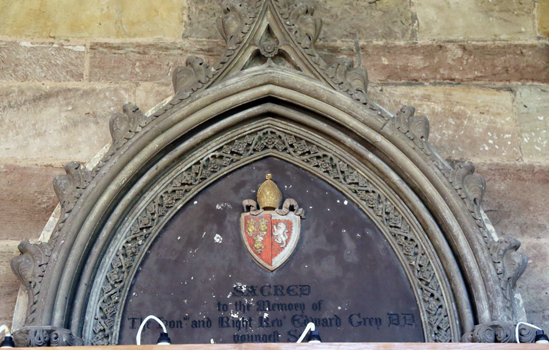 |
|
| Now totally illegible | Two 19th century
bishops: left, George Isaac
Huntingford DD FRS (1815-1832) and on
the right his successor,
Edward Grey DD (1832-1837) Both now obscured behind a screen in the café |
||
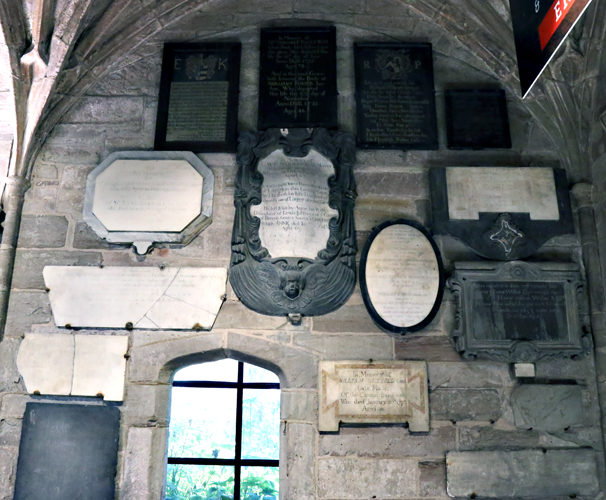 |
 |
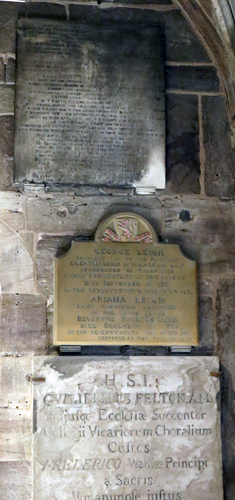 |
| Top Row: i.
Edward [Hu]ing (_86) Latin
text. ii. Margaret Fisher (1721)
and her son, Abraham Fisher
(1721). iii. Richard Philpotts
(1673) Latin text. iv. Illegible. Second Row: i. Richard Barroll (1810) and Anne Barroll (1812). ii. Cave Woodhouse (1736) and his wife, Anne (1743) iii. _uings_ Third Row: i. Stu_ Fleming. ii. Catherine Mainwaring, Cavendish Mainwaring, Hariett Mainwaring and others. Latin. iii. Hanna Williams (165_) Latin Fourth Row: i. Worn smooth. ii. William Russell (1776) Bottom Row: |
Top Row:
Benjamin Fellows ? Second Row: i. Illegible ii. Illegible. Latin iii. John Rudd AM (1746) Third Row: i. Mary Jones (Bullock) (1793) and her sister, Elizabeth Frith (Bullock) (1830) ii. Thomas Llanwarne (1805) Solicitor. iii. Elizabeth Taylor mostly illegible Fourth Row: i) Wathen ii) Julianna Lane (Rod) Litin script. iii) A_Evans (Preston) Latin. iv. _ Holmes (1708); his son, William (1799) and his wife Mary (1792); their son, Thomas Holmes. Bottom Row: i) _Letitia _ ii. 1979James Rennell Rod, 1st Lord Rennell of Rod PC GCB GCMC GCVO (1860) |
Top: Most of this can be read except for the name: Mas_ Symon_Power Middle: George Leight (1816) and his sister, Ariana Leigh Bottom: William Felton AM. Latin text |
| For Richard Philpotts,
see above [54] The text - certainly innacurate - of these difficult to make out monuments was taken from enlarge photographs. Never the best way but I could not see them in the church! |
||
The RCHM reports in the East Walk, two brass indents [5,6] |
||
| Egerton Leigh DCL (1760) Prebendary of Bullingham and other ecclesiastical posts. His son Peter Leigh (1758) Prebendary of Pionia Parva; His second son, Egerton Leigh (1798) Archdeacon of Salop | Tablet with shield of arms | |
| Very Rev William Leigh (1809) Dean of Hereford. Very Rev Edward Mellish (1830) Dean of Hereford who married Elizabeth the daughter of Dean Leigh | Tablet with four shields of arms | |
| Emily W Whitfield (1826) Age 16. The organist's daughter. | White tablet on black base | |
| Percy Clarke Hull, Knight, Mus Doc, FRCO, LRAM, Hon ARCM (1960) Organist and Master of the Choristers; Sub-Canon | Gray tab | |
| John Clarke Whitfield Mus Doc (1836) Professor of Music. His wife, Susanna (1845) | White tablet with arms | |
| Dorothy Carless (1827) 'late of the City Spinster, | White oval tablet on black base | |
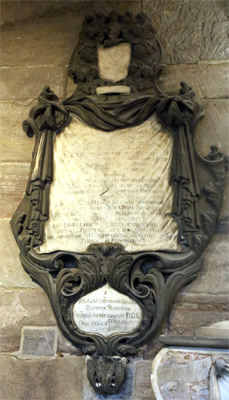 |
|
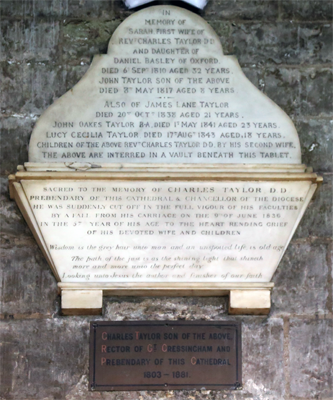 |
||
| Latin text and difficult to make out: Mariam, wife of Edward Honeywood...On the lower section, which appears to be of a later date, it states that the monument was erected by the first son, Thomas, and gives the date of death as 1717. | Upper
section: Sarah Taylor (Basley)
(1810), the first wife of Rev
Charles Taylor. their son, John Taylor
(1817) at 8. Also James Lane
Taylor (1838) and Lucy Cecili
Taylor (1843), children lf the
Rev Charles and his second wife. 'The above are
interred in a vault beneath this tablet'.
Lower section: Rev Charles Taylor
DD (1863) Prebendary
and Chancellor of the Diocese. 'suddenly cut off
in the full vigour of his facilities by a fall
from his carriage. Brass below: CharlesTaylor (1881) Rector of Cressingham and Prebendary. Son of the above. |
| NOTES | |
| -1 | A Puisne Judge is of inferior rank to a Chief Justice in some jurisdictions. Now an obselete term |
| The RCHM reports that there are 14 floor slabs in the court yard of the Bishops' Cloister dating from the 15th to 18th centuries but before the cutt off date |
[46] Sandstone slab with effigy of (?) woman in long gown 13th or early 14th centuries. Poor, head missing.


